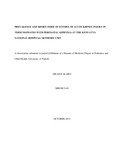| dc.description.abstract | ABSTRACT
Background
Perinatal asphyxia contributes significantly to perinatal morbidity and mortality especially in resource poor countries, with a mortality of 31.1% by day 7 of life in Kenyatta National Hospital Newborn Unit. The high incidence of perinatal asphyxia (50-72%) and its severity appear to correlate with increasing incidence of AKI. The kidney is the most damaged organ in asphyxiated full-term infants, with effects seen within the first 5 days of birth with up to 40% of survivors having residual kidney dysfunction.
The study was designed to provide local data on this condition.
Objectives
To determine the prevalence and short term outcomes of perinatal asphyxia-associated acute kidney injury (AKI).
Methods
We conducted a prospective cohort study including 60 full-term neonates admitted at the Kenyatta National Hospital newborn unit in Nairobi and suffering from perinatal asphyxia from 1st June 2012 to 30th November 2012. Renal function was assessed by measuring serum creatinine on day 3 of life. AKI was defined by a level of creatinine above 133 μmol/l. The hypoxic ischaemic encephalopathy (HIE) (degree of neurological impairment) was determined according to Sarnat classification daily until patient discharge, death or day 7 of life.
2
Results
Of the 968 newborns admitted into the KNH NBU during the study period, 60 infants met the inclusion criteria with 36.2% of the neonates having HIE I, 51.7% HIE II and 12.1% HIE III. The mean weight was 3373 g (SD=427.3) and length 52.3 cm (SD=2.1). The neonates weight ranged from 2620 to 4600 g. There were 37 male neonates and 23 female neonates. Most of the neonates were delivered in KNH (76%), 24 % delivered in other health facilities.
Seven out of the sixty neonates met criteria for AKI on day 3 giving a prevalence of 11.7 %. Out of the neonates with AKI, 11.1 % (4/36) of the males were affected versus 12.5 % (3/24) of the females. There was a 15 fold increase risk of developing AKI in HIE III compared to HIE I, p=0.034 {95% CI (1.2-183.6)}. The mortality rate in perinatal asphyxia associated AKI was 71.4 % with a 24 fold increase risk of death in neonates with AKI, p=0.001{95% CI (3.7-157)}. Median day of death in neonates with AKI was 4.5 days. Of all the neonates admitted 36% without AKI remained admitted beyond day 7 of life compared to 14.3% with AKI. Of the neonates with AKI, 5 died by day 7 of life. Only 14.3% of neonates with AKI were discharged home by day 7 of life.
Conclusions
AKI is common in neonates with asphyxia (1 out of every 8 neonates) and associated with poorer outcomes in the background of perinatal asphyxia (mortality rate of 71 %.). AKI correlates well with the severity of HIE. Larger studies need to be done to correlate maternal factors and perinatal asphyxia-associated AKI, and to assess the long term outcome of babies with perinatal asphyxia-associated AKI discharged from the newborn unit. | en |

